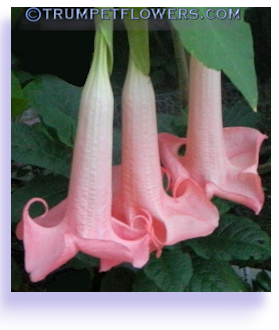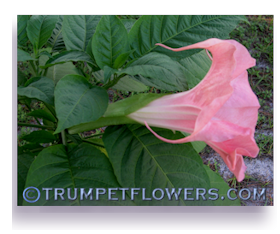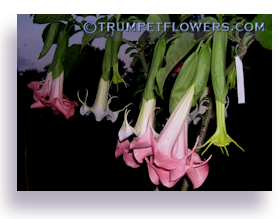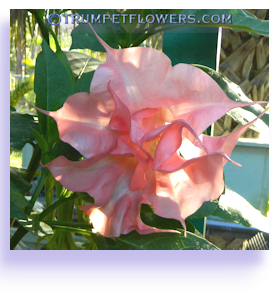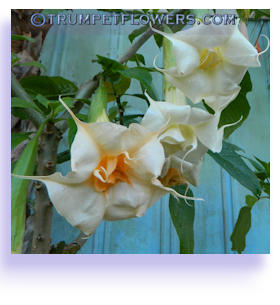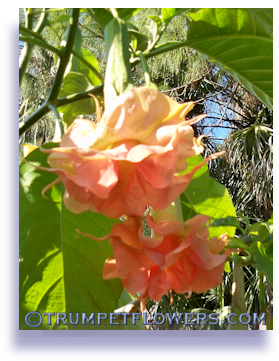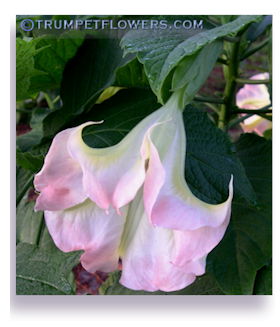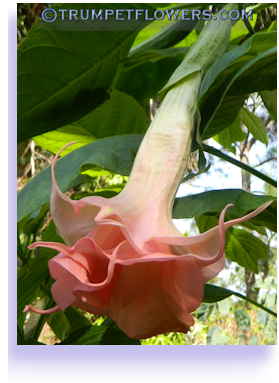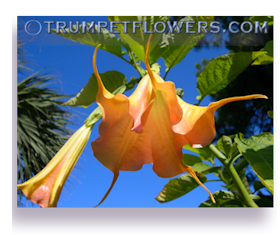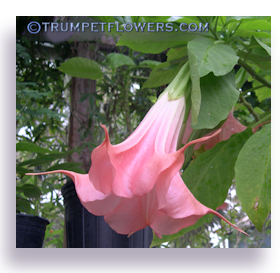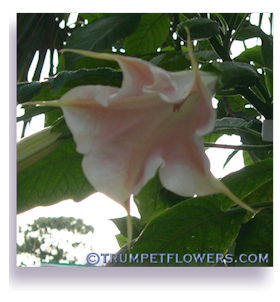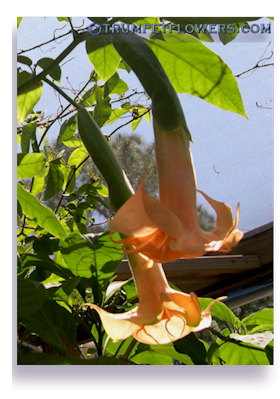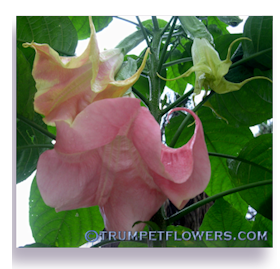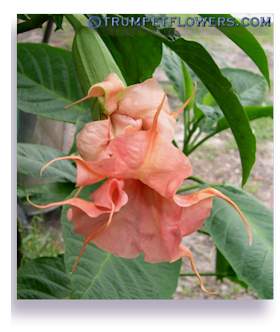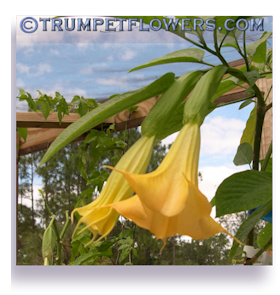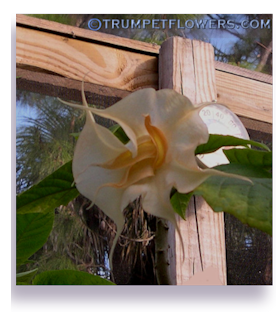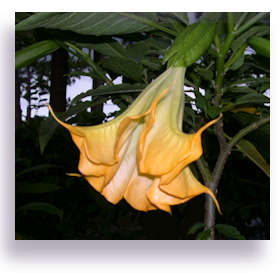Care and Grow
Angel Trumpets
If you have just received an Angel Trumpet, read this: Trumpet Flowers Immediate Care
The Basics of Keeping Brugmansia
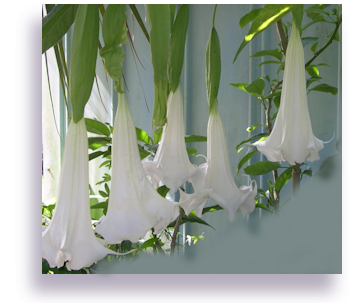 For those of us lucky enough to live in Climate Zone 9 and above, growing brugmansia, or Angel's Trumpets as they are commonly called, is fairly easy. There are a few rules though, and as with any plant, basic needs must be met.
For those of us lucky enough to live in Climate Zone 9 and above, growing brugmansia, or Angel's Trumpets as they are commonly called, is fairly easy. There are a few rules though, and as with any plant, basic needs must be met.
If you live in climate zone 9, your brugmansia can be placed in the ground, but it will die down after a frost. If you mark the spot, and continue in spring to fertilize and water it, the plant will come back with full vigor. It will also regain size enough to bloom that same year. Just think of it as an annual.
In zone 10, you have no worries. In ground, with no frosts, and the plant continues to grow. A brugmansia that is loved and cared for can eventually reach heights of 20 feet or more.
If you are unfamilar with exactly what climate zone you live in, go to this page: Updated 2012 (Florida) Climate Zone Map. If you live in another state, check out this map instead. Hardiness Maps, Choose your Country and or state.
Zone 9'ers can avoid all of this by placing it in a large fanciful planter, which brugmansia love anyway. They look great gracing an enclosed pool cage, next to your patio furntiure, the sweet baby powder scent wafting on the breeze for all of your guests. Mmmmmmm! Just throw a sheet over it for the few light frosty hours it might endure in zone 9, or pull it just inside the sliding glass doors until morning.
For others, it is also very easy to grow brugmansia. You just have to bring them inside into a basement or warm garage come frosty temperatures. They will go dormant and live quite happily through the winter in this form. We'll talk more about that later.
By the way, brugmansia are very. very happy being grown as container plants. A large patio pot with a diameter of 22 inches or so will give enough root foundation to allow the plant to branch out, and grow to a large enough height to to create branch after branch of hanging blooms. In less than a year, and from a cutting, I had the cultivar Dorothea go from a simple twig to over 6 feet of small tree literally covered in tons of blooms many times a year.
Brugmansia in the Home land
A friend of mine who lives in the tropical regions of South America, where angel trumpets are from; has informed me that after years of keeping them herself, and watching them grow from year to year in the soils of the cleared jungle she lives at, has seen them spread from the main trunk through suckering and underground rooting. This means that if brugmansia is allowed to grow in her natural environment, she will spread by underground rootings that spring up from the ground in great distance, and suckers from the base of the mother angel trumpet.
My same friend also told me that throwing a cutting down on the ground in such a place, will even root without being covered with soil. So in angel trumpet's home land, the plant is very resilient. And even here in the states, the plant seems to be as tough as iron. Even if strong tropical storm force winds snap a branch off, I can easily root it. Brugmansia is a strong plant, and a great plant for beginners and seasoned gardeners alike.
The height and spread of these in ground angel trumpets is astounding. She reports that her brugmansia, never threatened by frost, grow in excess of 25 feet high, and a canopy spread of almost as wide. A beautiful thing to behold, as hundreds of blooms hang easily from the branches, the scent so strong it can be smelled a mile away.
Heat and Brugmansia
Let's face it, in heat waves most brugmansia wither, just like we do. That includes what we call 'The Warm Group' Brugs. They are originally from the understory jungles of Ecuador, Columbia and other nearby countries. Strong, but dappled equatorial sunlight kisses their leaves daily, giving way to fat, healthy blooms that swing gently in the wafted breezes of sunny summers.
Keeping that in mind, if you live in an arid climate such as the southwestern desert, or a place with very hot albeit humid; summers, then by all means keep your brugmansia collection out of the direct blazing sun of the afternoons. Make sure to check it frequently for water loss during these conditions. If you do this, your angel's trumpets may lose a few leaves, but otherwise should do just fine.
Angel's trumpets do shed their leaves on a regular basis, (especially in heat) so keep them picked up and discard properly. Same with spent blooms. Brugmansia blooms last anywhere between 3 days up to a week, depending on the outside temperatures. When blooms start to wilt, remove them quickly by pinching them off at the top of the peduncle, near the branch it is attached to. Blooms left longer will give an untidy appearance and attract unwanted pests, just like fallen leaves.
It is also good to know that during hotter temperatures, the same bloom that might have opened that very morning will wilt and look like it is dying by the time afternoon arrives. If it is a new bloom, don't worry about this. Just keep it well watered. Overnight, when the temperatures drop back down, the same flower will revive and look good for you in the morning.
Blooming Time for Brugmansia
Dependng on the cultivar, your brugmansia should bloom from early spring and off and on all summer and into fall. The older the plant gets, and the better you meet it's growing requirements, the more frequent the blooms will be, as well as en masse. Fall does seem to be the best time for perfectly shaped flowers with large flushes. Have your camera ready for some most likely spectacular photos of blooms come the cooler fall months.
Brugmansia also have some unique habits that need met before they will bloom. Make sure to read the page Getting Brugmansia To Bloom for many photos and pertinent information on the angel's trumpet habit.
Soil
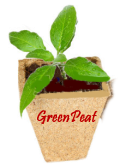 Soil mixes for brugmansia is largely the same, except for a few cultivars that are slower at growing than most, and require less water. Culebra being one of those, and mine like more sand in the mix. Hybrids from these same species may also require a lighter soil. But for the most part, angel's trumpets love their roots set in a rich, loamy, airy soil that drains well and has a lot of organic material and micronutrients in it. There I have a specific brugmansia soil mix I always use. Here's a link to the page: Do It Yourself Soilless Mixes page.
Soil mixes for brugmansia is largely the same, except for a few cultivars that are slower at growing than most, and require less water. Culebra being one of those, and mine like more sand in the mix. Hybrids from these same species may also require a lighter soil. But for the most part, angel's trumpets love their roots set in a rich, loamy, airy soil that drains well and has a lot of organic material and micronutrients in it. There I have a specific brugmansia soil mix I always use. Here's a link to the page: Do It Yourself Soilless Mixes page.
For those of you who need a pictorial on making a soil mix for your brugmansia, and an easy way to save your back, try my tutorial here: How to Make Potting Soil for Brugmansia, step by step, photos
Soil Ammendments are a nice addition. These help to 'build' the soil up, and enrich it. The plant takes in the micronutrients and trace elements that are contained in these ammendments, and grow. Strong roots make strong trunks. Strong trunks support good, thick green leaves and large, waxy flowers. Cheating your plant out of these ammendments will only cause it to langer; and never allow it to reach it's full growth potential. I have made a couple of tables containing organic ammendments on the page Soil Ammendments.
And if you live in the Fort Myers, Naples area of Southwest Florida, then green peat can definitely give your brugmansia plants that perfect soil mix they love. Click the picture of the peat pot above for the Craigslist posting right here in Fort Myers.
Water
 Water used on your brugmansias, and any other garden plant for that matter; deserves a subject all unto itself. Please Click Here to read all about the differences in watering and how to make yours the best plants they can possibly have.
Water used on your brugmansias, and any other garden plant for that matter; deserves a subject all unto itself. Please Click Here to read all about the differences in watering and how to make yours the best plants they can possibly have.
Make sure to check the brugmansia(s) several times a day in the strong heat of the dog day summers. You are looking for leaf wilt. If this happens, give them a good, long drink from the garden hose. Within 15 minutes, you should see the plant recover. Most cultivars and species of brugmansia enjoy slightly moist roots.
However, if you have your plant in a protected area and it continues to wilt, or you know it has enough water, you might have another problem. Try reading this section on Bruggie Q & A: Brugmansia, Wilting
Light
Brugmansia require bright, sunny spots in your garden in order to bloom the best. However, if you live in hot, arid desert climates or other places that the sun and heat become quite intense during summer, they will need protection. In those cases, protect them by placing them underneath nice sized ornamental trees with nice canopies. Dappled sunlight will be enough for your angel's trumpets to still give you great flower flushes in the case of such glaring heat waves.
Nutrients, Micronutrients & Fertilizers
Brugmansia, being in the solanacae family, are heavy feeders. This means you'll need to keep them growing and happy, sending up new blooms for you. There are several really good products used by gardeners for this. One is Osmocote. Available at Lowes and Home Depot, Osmocote contains micronutrients that help to support the growth rate of your brugs. It also lasts 3 to 4 months before needing replacing. Read the instructions for use, and make sure you use in your soon-to-use soil mixes. This way the beads of micronitrients will get right to the root system where it is needed.
A great liquid micronutrient and vitamin mix is Superthrive. I have used it for years, and really like the results I receive. It is also wonderful for helping tender cuttings get started, or the transferance of a new and delicate plant to a larger pot, or the ground.
Now let's talk fertilizers. Brugs will eat a lot of these, in mixed numbers. N-P-K is the chemical name for Ammonia-Phosphorous-Potassium. Start paying attention to the bags of fertilizer you buy for your grass or other plants. Notice the three numbers? A common example is 6-6-6. That means there are about 6 percent of each of the 3 nutrients listed above mixed well and contained in the bag. The rest of the stuff is inert fillers, to hold and support the nutrients and keep you from burning your plants by adding too much to one spot. Of course, liquid∼use fertilizers are really concentrated, have much less fillers, and you will need to carefully follow the instructions for use.
For more on Fertilizing and the use of it, visit this page: Getting Brugmansia to bloom. It will go into more detail and tell you the NPK numbers that brugmansia prefer.
Stop Fungal Attacks
In some cases, Brugmansia can be overcome with fungicidal problems if they are not addressed right away. To stop this from even happening, try treating them with a fungicide preventative, just as you would roses or any of your other beloved garden gems. A good one to use for brugs is Organic Garden Fungicide. Another one I use to dip my cuttings in, and treat the ground itself is Actinoviate, available at Amazon. Both are natural and do not harm the environment, but will greatly aid in keeping fungal issues at bay in your growing collection.
Keeping Brugmansia Happy and Bloom∼Flushing
A good working combination of everything we talked about above is the basics for healthy brugmansia plants. You will find that different hyrbrids and species will react slightly differently to light and water, fertilizer amounts, but their basic needs will remain the same.
Learn to recognize the differences in your cultivars. Beyond what I have gathered as information, note how one reacts to full sun in the heat of the day. Is it causing the plant undue stress? Do the leaves wilt when you water the plant? Perhaps you are actually overwatering this particualr brugmansia. Many of them have their little differences, and noticing these differences will help you in properly attuning their care and ending up with more blooms and healthier, more disease and pest resistant brugs.
There are other factors one must take into consideration to get the biggest and best blooms from their angel's trumpets. I wrote a whole section it. Visit Revitalizing Your Brugmansia for more.
Repotting
Repot a brugmansia when you see extensive feeder roots on the surface of the pot and you notice it is lighter in weight than when originally potted, (or purchased) This means the plant has taken up many nutrients from the soil, causing it to lighten, and it may even become top∼heavy and blow over in heavier winds. Since they grow so quickly, the 2 inch diameter size for repotting really does not apply here. I regularly repot mine from a 10 gallon to a 20 gallon pot, simply because I feed them on a regular basis, and within no time (one season) they will have refilled the 20 gallon pot.
Make sure when you do repot, that you give it a cushion of soil at the new pot's bottom, so that the roots in the old pot do not kiss the bottom of the new pot. Here is more information on repotting brugmansia.
When repotting, you may also be able to take stem, branch or twig cuttings of the brugmansia. This will potentially give you more baby brugmansia. To learn how to properly do this, read the Propagation page on How to properly take stem cuttings.
Brugmansia and Datura are toxic
Brugmansia and datura are toxic. Be sure to keep all parts of the plants away from children and animals. Some people are so sensitive to them they need to wear gloves when working around them. I personally have never had this issue, and have never worn gloves, be it when taking cuttings, re-potting, etc. Neither have but one of about 50 or so of my hybridyzer friends who grow them. So, one out of 50 isn't bad. But be sure to take precaution around these lovely, but potentially neurotoxic; plants.
Shamanistic rites and strange history of the plant's use have been found in records as far back as 3500 years ago. Pre-Columbian and Andean tribes still use them in their rituals. They contain belladonna alkaloids such as atropine, hyoscyamine and scopolamines.
All in all, don't let this scare you away from growing them. Brugmansia have been used as ornamental plants for over 200 years, beginning with English naturalists and then beloved and cultivated further in the Victorian era. Only folks with an ulterior motive to start with are reported as being harmed by this lovely plant. So go right ahead and grow this under∼canopy tree with no worries, just be aware of keeping young people safe. I had a cat chew on the first brug I ever kept, and it had no ill effects. Perhaps their systems are different, and it does not affect them the way it does humans.
Holes in Leaves of Brugmansia are usually caused by caterpillars of the sphinx family of moths. Since my collection is extensive, and I am a green gardener as much as possible, I allow them to eat what they want, and continue upon their life cycle. I know that many of you readers are just starting and cannot lose leaves at this rate, so you may elect to pick off the caterpillars and destroy them. But I hope that if your angel trumpet tree is large enough, or you have more than a few, that you do allow the caterpillars to live. You will know what you can allow, the choice is yours. The moths are fantastically beautiful, you can see more of the different species of the adult sphinx moths (also called hawk moths) here. One other pest that is very detrimental, and I do elect to kill it, is the worms of the weevil, listed above. If you find them in your flower buds, do destroy them. They are very bad pests and should be eliminated.
Family Pronunciation: so-lan-AY-see-eye or: so-lan-AY-see-ee
For sounded out pronunciation: HJsay, solanaceae
Note: For a list of the world's climate maps, including each of the states, click here: Garden, Hardiness Maps
Note: For you Aussies, here is additional information from your lovely country on planting zones, where I found my map: Australian National Botanic Gardens. And for the Europeans, Here's your map.


